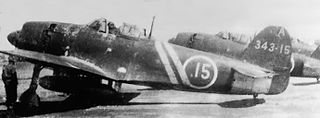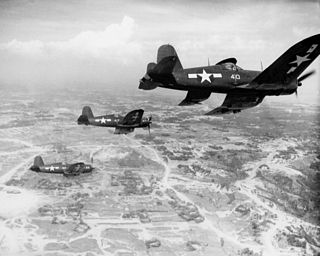
The Vought F4U Corsair is an American fighter aircraft which saw service primarily in World War II and the Korean War. Designed and initially manufactured by Chance Vought, the Corsair was soon in great demand; additional production contracts were given to Goodyear, whose Corsairs were designated FG, and Brewster, designated F3A.

USS Bunker Hill was one of 24 Essex-class aircraft carriers built during World War II for the United States Navy. The ship was named for the Battle of Bunker Hill in the American Revolutionary War. Commissioned in May 1943 and sent to the Pacific Theater of Operations, the ship participated in battles in the Southwest Pacific, Central Pacific and the drive toward Japan through Iwo Jima and Okinawa, and air raids on the Japanese homeland.

Fighter Squadron 61 (VF-61), the Jolly Rogers, was a fighter squadron of the United States Navy. Originally established as VF-17 on 1 January 1943, it was redesignated as VF-5B on 15 November 1946, redesignated as VF-61 on 28 July 1948 it was disestablished on 15 April 1959. It was the first navy squadron to be designated VF-17.
Henry Barrett Tillman is an American author who specializes in naval and aviation topics in addition to fiction and technical writing.
Fighter Squadron 11 or VF-11 was an aviation unit of the United States Navy. It was originally established as VF-5 on 1 February 1927, redesignated as VF-5S on 1 July 1927, redesignated as VF-5B in January 1928, redesignated VB-1B on 1 July 1928, redesignated VF-5B on 1 July 1930, redesignated VF-5S in July 1932, redesignated VF-5B in April 1933, redesignated VF-4 on 1 July 1937, redesignated VF-41 on 15 March 1941, redesignated VF-4 on 4 August 1943, redesignated VF-1A on 15 November 1946, redesignated VF-11 on 2 August 1948 and disestablished on 15 February 1959. It was the second US Navy squadron to be designated VF-11.

Fighter Squadron 111 (VF-111), also known as the Sundowners, was a fighter squadron of the United States Navy. Originally established as Fighter Squadron 11 (VF-11) on 10 October 1942, it was redesignated as VF-11A on 15 November 1946, redesignated as VF-111 on 15 July 1948 and disestablished on 19 January 1959. On 20 January, another squadron, VF-111 (1956-95) then assumed the designation until its de-establishment in 1995. In November 2006, VFC-13 Detachment Key West was redesignated as VFC-111, taking on the Sundowner insignia and callsign.

Marine Fighter Attack Training Squadron 501 (VMFAT-501) is a training squadron in the United States Marine Corps, consisting of 28 F-35B Lightning II aircraft and serves as the Fleet Replacement Squadron. Known as the "Warlords," the squadron is based at Marine Corps Air Station Beaufort, South Carolina and falls administratively under Marine Aircraft Group 31 and the 2nd Marine Aircraft Wing. The squadron has assumed the lineage of VMFA-451 which was originally known as the “Blue Devils” and saw action during World War II and Operation Desert Storm. They were decommissioned on January 31, 1997.

Kiyoshi Ogawa was a Japanese naval aviator ensign (少尉) of the Imperial Japanese Navy during World War II. As a kamikaze pilot, Ensign Ogawa's final action took place on May 11, 1945, during the Battle of Okinawa. Piloting a bomb-laden Mitsubishi Zero fighter during Operation Kikusui No. 6, Ogawa flew through American anti-aircraft fire and attacked the U.S. Navy aircraft carrier USS Bunker Hill, less than one minute after his flight leader, sub-lieutenant Seizō Yasunori, crashed into the ship. He dropped a 250-kilogram (550 lb) bomb, never pulled out of the dive, and crashed deliberately into the flight deck near the control tower of the aircraft carrier. The bomb penetrated Bunker Hill's flight deck and exploded. Gasoline fires flamed up and several explosions took place when re-armed and re-fueled planes on deck exploded and caught fire. 393 American sailors died with Yasunori and Ogawa, 264 were wounded, and the ship was disabled for the remainder of the war.

John Thomas Blackburn was an American naval aviator, World War II flying ace, and the first commanding officer of the famed F4U Corsair squadron VF-17 Jolly Rogers.

Marine Fighting Squadron 511 (VMF-511) was a fighter squadron of the Marine Corps and Marine Forces Reserve during World War II and the Cold War which flew aircraft types such as the F6F Hellcat, F4U Corsair, and the F-8 Crusader. They were originally activated during World War II and fought during the Battle of Okinawa and the Battle of Balikpapan (1945). They specialized in close air support and during the course of the war were credited with only one plane shot down.

VF-121 of the US Navy was a former Pacific Fleet Replacement Air Group (RAG) unit. Originally established on 1 July 1946, as VF-781, it was redesignated as VF-121 on 4 February 1953 and disestablished on 30 September 1980. On 11 April 1958 it changed duty from Fleet Squadron to Fleet Replacement Squadron and was later charged with the training of Navy F-4 Phantom flight and maintenance crews.

Rear Admiral Edward Lewis Feightner was a United States Navy officer who fought in a number of significant battles in the World War II Pacific Theater of Operations. During two combat tours, he shot down nine enemy aircraft to become a flying ace.

The 343rd Naval Air Group was an aircraft and airbase garrison unit of the Imperial Japanese Navy (IJN) during the Pacific campaign of World War II. Created in late 1944 due to the desperate situation of Japan in the closing stages of the war, the 343rd was composed of the best surviving ace fighter pilots the Imperial Navy had at the time, with Captain Minoru Genda in command. This unit was equipped with the best airplane Japan had left by then, the Kawanishi N1K2-J Shiden-Kai, known as George by the Allies; this aircraft could compete with the best wartime Allied fighters, namely, the F6F Hellcat, the P-51 Mustang and the F4U Corsair.

1833 Naval Air Squadron was a Naval Air Squadron of the Royal Navy's Fleet Air Arm between 1943 and 1945 and then again from 1947 to 1957.
Fighter Squadron 8 or VF-8 was an aviation unit of the U.S. Navy, originally established on 1 June 1943, it was disestablished on 23 November 1945. It was the second US Navy squadron to be designated VF-8.

Fighter Squadron 80 or VF-80 was an aviation unit of the United States Navy. Originally established on 1 February 1944, it was disestablished on 16 September 1946. It was the first US Navy squadron to be designated VF-80.

Ira Cassius Kepford was an American flying ace of World War II who served with a land-based unit of the United States Navy. In 76 days of combat flying with the VF-17 "Jolly Rogers," he was credited with shooting down 16 enemy aircraft. At the close of his combat service in April 1944, Kepford was the Navy's leading ace.
Archie Glenn Donahue was a decorated American combat pilot and a United States Marine Corps fighter ace during World War II. He shot down a total of 14 Japanese planes during the war, including five in a single day.

The Tactical Air Force, Tenth Army (TAF) was a joint aviation command of the Tenth United States Army that was responsible for commanding all land-based aviation and aviation command and control units during the Battle of Okinawa. The TAF's headquarters was provided by the 2nd Marine Aircraft Wing and it was the largest joint aviation unit under Marine Corps command during World War II. During the battle, the TAF was commanded by Major General Francis P. Mulcahy until ill-health forced him to be relieved by MajGen Louis E. Woods. According to United States sources, TAF aircraft were responsible for shooting down 637 Japanese aircraft during the battle.

Dean Caswell was a United States Marine Corps flying ace during World War II. He accrued seven victories in the war. He retired from military service in 1968 at the rank of colonel. He was the last living Marine Corps flying ace of World War II.














